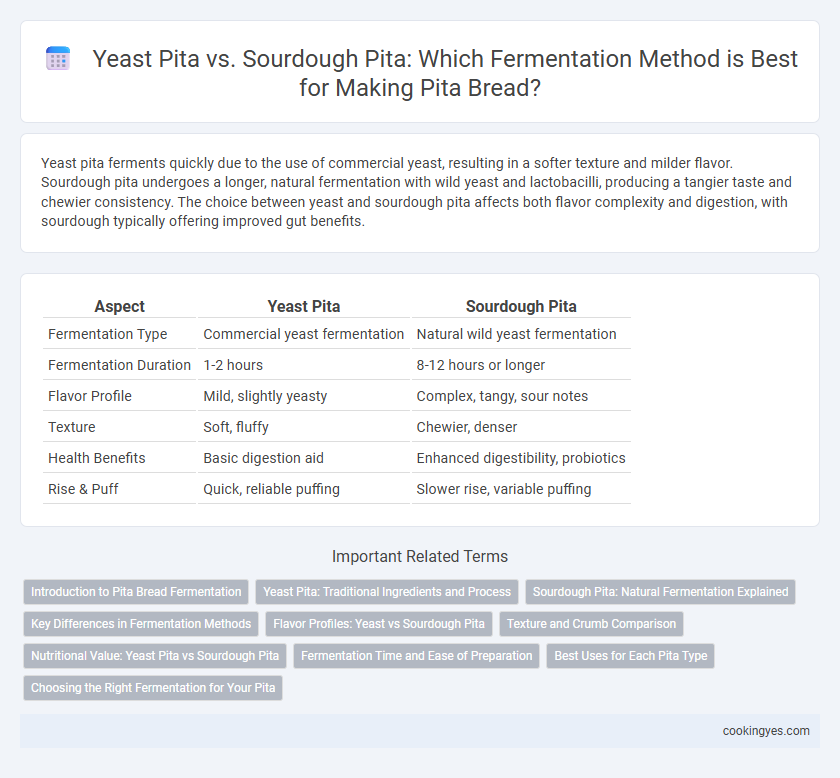Yeast pita ferments quickly due to the use of commercial yeast, resulting in a softer texture and milder flavor. Sourdough pita undergoes a longer, natural fermentation with wild yeast and lactobacilli, producing a tangier taste and chewier consistency. The choice between yeast and sourdough pita affects both flavor complexity and digestion, with sourdough typically offering improved gut benefits.
Table of Comparison
| Aspect | Yeast Pita | Sourdough Pita |
|---|---|---|
| Fermentation Type | Commercial yeast fermentation | Natural wild yeast fermentation |
| Fermentation Duration | 1-2 hours | 8-12 hours or longer |
| Flavor Profile | Mild, slightly yeasty | Complex, tangy, sour notes |
| Texture | Soft, fluffy | Chewier, denser |
| Health Benefits | Basic digestion aid | Enhanced digestibility, probiotics |
| Rise & Puff | Quick, reliable puffing | Slower rise, variable puffing |
Introduction to Pita Bread Fermentation
Yeast pita fermentation relies on Saccharomyces cerevisiae to rapidly produce carbon dioxide, resulting in a soft, airy texture with characteristic pocket formation. In contrast, sourdough pita uses wild yeast and lactic acid bacteria from a natural starter, which imparts complex flavors and a slightly tangy taste due to organic acid production. Both methods influence dough rise and texture, but sourdough fermentation requires longer time for microbial activity, enhancing the nutritional profile through fermentation byproducts.
Yeast Pita: Traditional Ingredients and Process
Yeast pita utilizes commercial baker's yeast as the primary fermenting agent, which accelerates the fermentation process compared to sourdough methods. Traditional ingredients include all-purpose flour, water, salt, and yeast, allowing for consistent rising and uniform pocket formation. This method produces a soft, airy texture with a mild flavor profile ideal for quick preparation and reliable results.
Sourdough Pita: Natural Fermentation Explained
Sourdough pita relies on natural fermentation using wild yeast and lactobacilli, which enhances flavor complexity and improves digestibility compared to commercial yeast pita. The slow fermentation process develops organic acids that contribute to a tangy taste and extend shelf life without preservatives. This method also increases nutrient availability by breaking down phytic acid, making sourdough pita a healthier and more traditional choice.
Key Differences in Fermentation Methods
Yeast pita uses commercial baker's yeast for rapid fermentation, resulting in a soft texture and quicker rise time, typically within 1 to 2 hours. Sourdough pita relies on natural wild yeast and lactic acid bacteria from a sourdough starter, producing a longer fermentation period of 12 to 24 hours, which enhances flavor complexity and digestibility. The extended fermentation in sourdough pita imparts tangy notes and improves shelf life compared to the milder taste and faster production of yeast pita.
Flavor Profiles: Yeast vs Sourdough Pita
Yeast pita offers a mild, slightly sweet flavor with a soft and chewy texture due to the rapid fermentation process producing less complex organic acids. Sourdough pita features a tangy, robust taste derived from natural wild yeast and lactic acid bacteria, resulting in a denser, more textured crumb and enhanced aroma. The extended fermentation in sourdough pita develops deeper umami notes and a subtle acidity that differentiates it from the neutral, straightforward flavor of yeast-leavened pita.
Texture and Crumb Comparison
Yeast pita offers a softer, fluffier texture with a more uniform crumb due to faster fermentation and higher carbon dioxide production, resulting in distinct air pockets. Sourdough pita features a denser, chewier texture with an uneven crumb structure, attributed to the longer fermentation and natural wild yeast activity that develops complex flavors. The acidity in sourdough also strengthens gluten, producing a more resilient crumb compared to the tender consistency of yeast-leavened pita.
Nutritional Value: Yeast Pita vs Sourdough Pita
Sourdough pita typically offers enhanced nutritional value compared to yeast pita due to its natural fermentation process, which increases bioavailability of minerals such as iron, zinc, and magnesium. The lactic acid bacteria in sourdough help break down phytic acid, an anti-nutrient that can inhibit mineral absorption, thereby improving digestibility and nutrient uptake. Yeast pita, while quicker to ferment, lacks these benefits and often contains fewer beneficial acids and enzymes that promote overall gut health.
Fermentation Time and Ease of Preparation
Yeast pita typically ferments within 1 to 2 hours, offering a quicker preparation process compared to sourdough pita, which requires 8 to 24 hours due to its natural wild yeast fermentation. The rapid fermentation of yeast pita simplifies the baking schedule, while sourdough's extended fermentation enhances flavor complexity but demands more time and active management. Yeast pita is preferred for ease and speed, whereas sourdough is chosen for depth of taste and traditional sourness.
Best Uses for Each Pita Type
Yeast pita offers a light, soft texture ideal for quick meals, sandwiches, and wraps, making it perfect for everyday use where a tender bite is desired. Sourdough pita, with its tangy flavor and chewy crust, excels in artisanal dishes, pairing well with Mediterranean dips and grilled meats due to its complex fermentation profile. Both types benefit from fermentation but differ in taste and texture, guiding their best culinary applications.
Choosing the Right Fermentation for Your Pita
Yeast pita offers a faster fermentation process, typically requiring 1 to 2 hours for dough rise, resulting in a soft and fluffy texture ideal for quick meals. Sourdough pita relies on natural wild yeast and lactic acid bacteria, fermenting over 12 to 24 hours, which develops complex flavors and improved digestibility. Choosing the right fermentation depends on whether you prioritize convenience and mild flavor (yeast) or extended fermentation with tangy taste and enhanced nutritional benefits (sourdough).
Yeast pita vs Sourdough pita for fermentation Infographic

 cookingyes.com
cookingyes.com